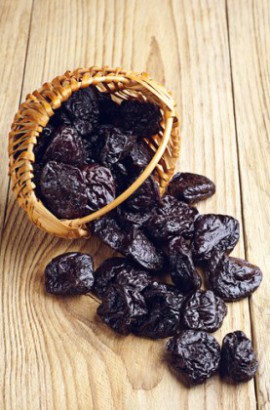10 Fruits rich in antioxidants
mis à jour le 7 October 2015 à 00:02
To combat the free radicals that “rust” our cells, there is nothing quite like vitamins and pigments rich in antioxidants. Here's the advice of nutritionist Françoise de Keuleneer.
Spiced prunes:
Well-endowed with polyphenols which fight against free radicals, prunes go very well with spices, which are packed with antioxidants. The suggestion of the nutritionist: have it for a tasty breakfast snack (serves 4). Soak a cup of peeled almonds and 8 prunes in water for twelve hours. Rinse. Wash 3 apples and 2 blood oranges. Remove the zest of ½ of an orange and chop finely. Mix the almonds, pitted prunes, fresh oranges and apples (cut into quarters) and a pinch of vanilla (or cinnamon) powder. Pour into bowls and garnish with slices of 2 apples (or 2 pears) and the chopped orange zest.
Raspberries for their fibres:
Extremely rich in vitamin C and polyphenols, they also contain lots of fibre, which facilitates the absorption of antioxidants. You can buy them frozen – that way, they are less costly and still retain their vitamins.
Blackcurrants, blueberries or blackberries for their pigments:
These berries proudly display their strong colours, and it is this very pigment that provides most of the antioxidants. A 50g portion of blackcurrants provides a third of the recommended daily dose of antioxidants. Blueberries and blackberries are also equally well endowed.
Pears (preferably organic):
If we want to maximize their benefits, “it is best to crunch on fruits with their skin on,” says Françoise de Keuleneer. When it comes to pears, however, opt for organic versions when possible because, like strawberry and tangerine, this is one of the most heavily pesticide-treated fruits.
Apples for their skin:
Antioxidants are present in the skin of fruits to protect them from external aggressions (cold, wind, heat). By munching on a medium-sized apple (125 g) with skin, especially if it is brightly coloured, we will have absorbed at least half of our recommended daily dose of antioxidants.
Citrus fruits for their zest:
In citrus, you should neither neglect the zest, which contain polyphenols (which are not present in the pulp) nor its white inner coating, which is rich in pectin (soluble fibres that facilitate the assimilation of the active substances). “Drinking squeezed citrus juice is therefore not the best way to enjoy the virtues of citrus fruits,” says the nutritionist. She suggests using the grated zest (untreated) often in the kitchen, over a grated carrot appetiser salad, for example.
Kiwi for vitamin C:
Belonging to the large family of antioxidants, vitamin C acts directly on the toxic derivatives of oxygen. Low in calories (50 calories per 100 g), the kiwi contains twice as much antioxidants as the orange.
Bananas for their quick assimilation:
This fruit contains antioxidants (vitamin C and dopamine) easily assimilated by the body. “Diversifying your sources of antioxidants is essential,” says Françoise de Keuleneer, “because they each have specific targets in the body. A simple guide: vary the colours of fruits consumed.”
Pomegranate to complement it all:
Laboratories are searching for the most antioxidant fruits to set them in juices, purees and capsules. Topping the list: pomegranate, açaí berries (a slightly chocolatey-tasting Brazilian palm fruit) and wolfberry. “Beware, a recent study has shown that too much antioxidants taken in the form of dietary supplements could be harmful to health,” says the nutritionist, “while there is no risk of overdose when consumed directly from fruits and vegetables.”
Nuts for their effectiveness:
Packed with polyphenols, nuts provide almost half of the recommended daily dose of antioxidants in just one portion (30g, three to four kernels). The best way to prepare for the best assimilation? Soak in water for 12 hours and rinse before eating. Nuts also go well with salads and desserts and work great as a garnish on soups.
Françoise de Keuleneer is the co-author, with Joel Pincemail, of “Couleur santé,les secrets de la cuisine antioxydante” (The Colour of Health, Secrets of the antioxidant cooking) (Françoise Blouard editions)
Martine Azoulai



